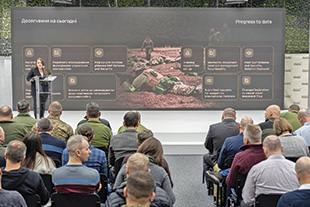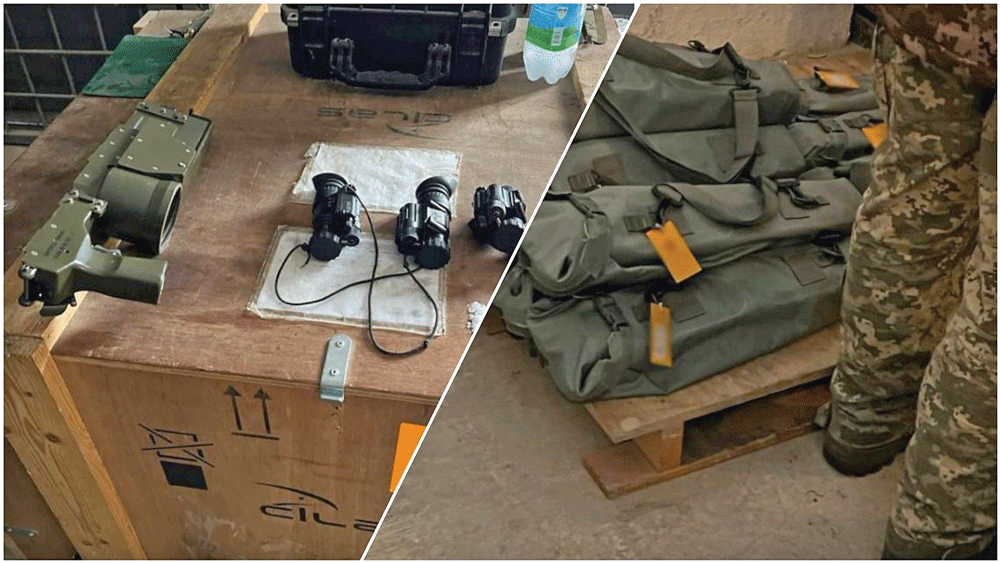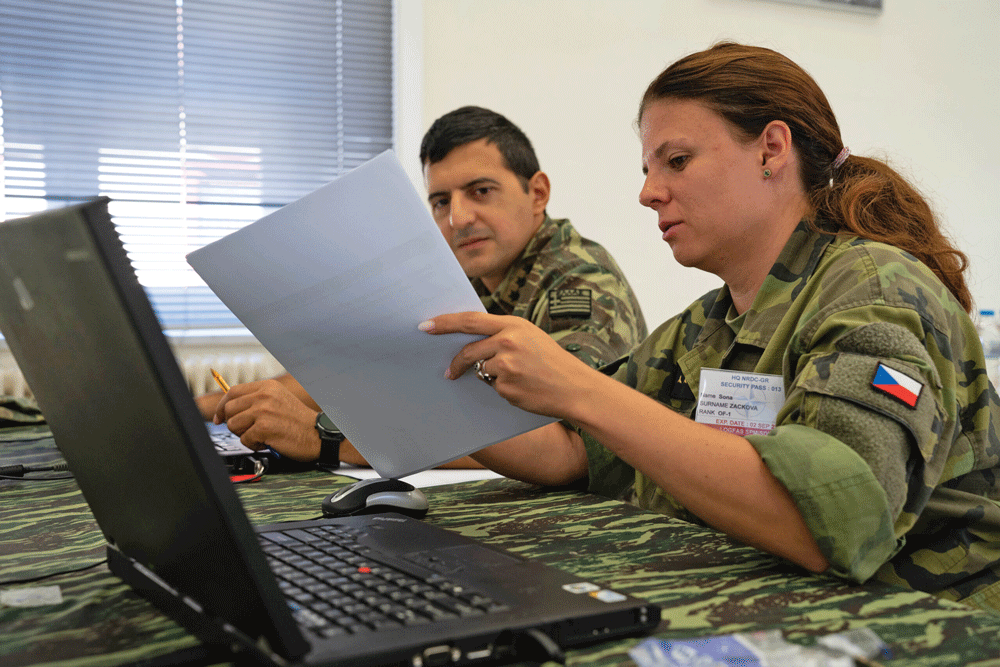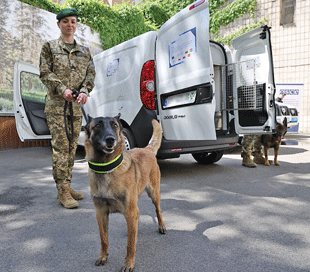Preventing Arms Diversion in Wartime Ukraine: A Brief Overview
CISR JournalThis article is brought to you by the Center for International Stabilization and Recovery (CISR) from issue 28.2 of The Journal of Conventional Weapons Destruction available on the JMU Scholarly Commons and Issuu.com.
By Olena Kryzhanivska, PhD [ Forum on the Arms Trade ]
Ukraine has entered its third year defending against Russia’s full-scale invasion, and despite emerging as one of the largest importers of weapons, it manages to prevent their major diversion. Experts evaluate the current arms control and weapons and ammunition management efforts by Ukraine and its allies with cautious optimism. Although obtaining detailed information about the intricacies of weaponry management in Ukraine is challenging, open sources allow us to glimpse some of the current measures taken during wartime. This article presents a brief overview of Ukraine's counter-diversion efforts and those of its partners, encompassing monitoring and control of international military aid, as well as border control measures. It also addresses the current challenges and opportunities for improving the situation.
Introduction
The reality of the Russian war in Ukraine has necessitated adjustments to normal arms control routines. The pace of decision-making regarding arms transfers, licensing procedures, shipment of weapons, as well as their distribution, use, and destruction, surpasses standard procedures. The strain of increased demands on these systems raises reasonable concerns about the potential spread of transferred weapons from Ukraine to other regions due to factors such as corruption, the challenging nature of physical security and stockpile management (PSSM) in times of war, Russia’s seizures on the battlefield, as well Ukraine’s reputation as “a hub of the illicit arms trade.”1
This piece provides a concise overview of the measures implemented by Ukraine and its partner countries aimed at mitigating the risk of the diversion of heavy weapons, as well as small arms and light weapons (SALW). It specifically addresses aspects such as record-keeping and control of international military aid transferred to Ukraine and border management practices. The article also discusses diversion resulting from battlefield capture by the Russian side. While not widespread, those instances of weapons diversion have been utilized by Russia for various purposes within the context of hybrid warfare.
Background

Institutional weakness, inadequacy of the national legal framework, widespread proliferation of weapons in society, and the enduring problem of corruption defined the initial decade of Ukraine’s existence as an independent state.
Following the acquisition of substantial stocks of conventional arms and ammunition from the Soviet Union, Ukraine, as a newly independent state, engaged in arms transfers to many countries. These countries included, but were not limited to, South Sudan, Syria, Chad, Kenya, and Libya.2 A Ukrainian parliamentary commission in 1998 revealed that, between 1992 and 1996, military stocks valued at US$32 billion had gone missing from inventories and were illegally sold abroad.3
Beginning in the 2000s, Ukraine adopted a more responsible approach to conventional arms control.4 In addition to those arms control treaties that Ukraine joined in the 1990s (e.g., the Wassenaar Arrangement, the Treaty on Conventional Armed Forces in Europe), the country also became a party to various international instruments in the 2000s, including the Firearms Protocol, the Programme of Action on Small Arms (PoA), and its International Tracing Instrument (ITI). Furthermore, Ukraine commenced the regular submission of reports on military spending (UN MilEx) and arms transfers (UNROCA).
The battle against corruption in Ukraine has persisted for decades and gained additional attention following the start of the full-scale Russian invasion. According to Transparency International, in 2023, Ukraine was ranked 108th out of 180 countries in the Corruption Perception Index, reflecting a slight improvement of eight points compared to 2022.5 A surge in law enforcement activities, particularly in investigating corruption cases within the military, along with high-level resignations occurring in 2022–2023,6 is intended to demonstrate to Ukrainian society, as well as allies, that Ukraine is becoming a more trustworthy and reliable partner.
Before the start of the full-scale invasion, Ukraine participated in several international projects aimed at modernizing its PSSM practices. The multi-year project launched by the Organization for Security and Co-operation in Europe (OSCE) in 2018 aims to prevent and combat illicit trafficking in weapons, ammunition, and explosives in all its aspects.7 Additionally, Ukraine collaborated actively with NATO in the destruction of obsolete conventional munitions, SALW accumulated since the Second World War.8
While the progress made by Ukraine in implementing the best PSSM practices is undeniable, the unprecedented influx of weapons and ammunition following the Russian invasion in February 2022—including heavy conventional weapons such as battle tanks, armored combat vehicles, combat aircraft, helicopters, large-caliber artillery systems, missile systems, uncrewed combat aerial vehicles, as well as remotely operated munitions, SALW, and their ammunition—has raised concerns about Ukraine’s ability to control and utilize such extensive weaponry properly. Fears regarding the possibility of large battlefield captures of transferred weaponry by the Russian side, along with existing disinformation campaigns aimed at discrediting Ukraine’s reliability, have added to the negative forecasts of the diversion of western weapons to unauthorized parties.9
The most feared scenarios of weapons diversion in Ukraine include:
- Diversion of weapons to terrorists and criminal groups due to inadequate control of storage and use.
- Diversion of weapons by the Russian side due to battlefield capture.
- State-sponsored diversion of weapons based on Ukraine’s high corruption rates and a previous record of diversion in the 1990s.
- Diversion of SALW and their proliferation within the country and adjacent regions due to increase of stocks in civilian custody.
The potential outcomes of these scenarios could contribute to armed conflicts in various regions of the world, as well as an increase in armed violence in Ukraine and neighboring countries. However, despite the accumulation of arms in Ukraine, there have been no major cases of illicit arms trafficking abroad.10
Monitoring and Control Over the Use of International Military Aid
In response to the swift escalation of weaponry inflows and concerns regarding their potential misuse,11 the Ukrainian Parliament (Verkhovna Rada of Ukraine) took action in July 2022 by establishing a special temporary commission to monitor the use of weapons provided to Ukraine by international partners during martial law.12 The primary objectives of this commission were to prepare and submit legislative initiatives outlining a model for parliamentary control over the receipt and utilization of international material and technical assistance. To date, the commission has compiled and released two reports detailing its activities.

In collaboration with its partners and allies, even before the beginning of the Russian full-scale invasion, Ukraine dedicated significant efforts to integrate a modern system of control over arms transfers. As outlined in the Preliminary Report on the work performed by the temporary commission as of January 2024, the information systems employed for accounting and monitoring include: the information and analytical system SOTA, Logistic Functional Area Services (LOGFAS), KOROVAI, and System Analysis Program Development (SAP) (Systemanalyse Programmentwicklung).13
The information and analytical system SOTA, implemented in 2022, operates within the apparatus of the National Security and Defense Council of Ukraine. The Ministry of Defense of Ukraine transmits daily updates to this system, providing information about received weapons and military equipment, as well as plans for their future acquisition.
LOGFAS is an integrated set of software systems developed to support NATO's logistics operations, facilitating coordination between NATO member states. It was officially introduced for use by the Armed Forces of Ukraine on 15 October 2022, although Ukraine has had limited access to LOGFAS since 2019. Since the summer of 2022, the Ukrainian military received a full license for usage. In 2022, Ukraine’s Ministry of Defense commented in an interview that the full-scale implementation of this service may take several years.14

KOROVAI is specialized software developed through collaboration between the United States, the United Kingdom, and Ukraine. It has been utilized by the Armed Forces of Ukraine since 1 September 2022. The Ministry of Digital Transformation of Ukraine oversees the monitoring of this system, while the Ministry of Defense of Ukraine manages the data input. The International Donor Coordination Center (IDCC) is responsible for overseeing international partners. This program enables the sending country to record the quantity and form of packaging of military aid, with its movement tracked until delivery to the Command of the Logistics Forces of the Armed Forces of Ukraine. The software allows for all participating users to be involved in planning needs and monitoring the movement of material resources to connect to the unified center of the Armed Forces of Ukraine.
SAP is a system specifically designed to automate logistics planning processes. Currently utilized for accounting spare parts, planning repairs, maintenance of military equipment, and automation of physical support, it plays a crucial role in enhancing efficiency.
Additionally, a barcode system is employed to track weapons arriving from the United States. Introduced in December 2022, this technology mandates that each weapon arriving from the United States is affixed with a barcode. Ukrainian military personnel then scan the barcode, instantly transmitting information about the weapon's serial numbers to a centralized database located in the United States. This streamlined process enhances traceability and ensures accurate record-keeping of the weapons received.15
In February 2024, the government of Ukraine endorsed the procedure for monitoring and controlling the use of international military aid.16 As outlined in the resolution,17 a series of logistics points will be established outside the country. These entities are meant to serve as the Ukrainian divisions of the international hub, consolidating the logistics network of partners from Ukraine.
Exporting countries bear a significant responsibility for overseeing the transfers of weapons and ammunition. In fulfilling this role, the United States, being the largest donor of military aid, maintains a military presence in Ukraine tasked with conducting on-site visits and inspections of arms stockpiles.18 Commencing in June 2022, personnel overseeing these operations from various US agencies initiated regular coordination meetings to streamline Ukraine's oversight activities. By the close of 2022, the working group comprised seventeen oversight organizations.19 In January 2023, the United States published a Joint Strategic Oversight Plan (JSOP) for Ukraine Response.20

The Ministry of Defense of Ukraine consistently communicates updates on inspections of international military aid carried out by US personnel. These inspections encompass the verification of key parameters, compliance with serial numbers, assessment of technical conditions, and evaluation of conditions for the proper storage of weapons, focusing on safety and security, directly at the weapon storage locations.21
On-site inspections are vital tools for controlling PSSM under ordinary circumstances. However, given the dynamic nature of war, where weaponry is sometimes transferred directly to the battlefield or stored in close proximity to the frontline, authorities are not always able to conduct physical inspections. The incapacity of specialists to execute comprehensive oversight over transferred weaponry due to evident limitations creates an opportunity for adversaries to disseminate vocal reports and engage in disinformation campaigns. In this situation, a preference should be given to alternative methods of weaponry monitoring and control, and new practices in end-use monitoring involving modern technologies.22
Border Control Measures
Maintaining an effective border control system is crucial for preventing the proliferation of weapons and ammunition to other countries and regions. Reports indicate that the disruption of existing illicit trade routes and organized criminal relationships may be contributing factors.23 For instance, the naval blockade of the port of Odesa deprived arms traffickers of their primary channel for selling arms on a large scale. Enhanced security measures across Ukraine, in the form of checkpoints and stops, make the transportation of weapons more challenging.24

For several years, Ukraine has collaborated with the OSCE to enhance its border protection mechanisms.25 Recognizing the heightened risks of illicit cross-border trafficking of weapons, the European Union (EU) initiated the Support Hub for Internal Security and Border Management in Moldova to address potential security threats arising from the Russian invasion.26 The EU Home Affairs Commissioner stated that the hub aims to prevent a situation akin to the post-Balkan war era, during which crime gangs in Europe exploited opportunities to build up their arsenal.27
The State Border Service of Ukraine utilizes the available technologies (SOTA, LOGFAS, and KOROVAI) to coordinate international military assistance, manage the logistics support of NATO, and communicate daily information on received weapons and military equipment to the National Security and Defense Council of Ukraine.28
In addition to these measures, a robust international police and prosecutorial cooperation framework between Ukraine and the European Union has played a positive role in uncovering cross-border organized crime activities.29
Challenges and Opportunities
The overview of modern software employed in Ukraine for recording and controlling military assistance provides insight into the new digitalized approach adopted by Ukraine and its allies. While the concept sounds promising in theory, its practical implementation poses significant challenges. Assessing the current stage of software implementation and the proportion of national weaponry recorded in the databases is challenging. Transitioning from traditional data-keeping methods, which involved hand-written journals, to modern technologies will require a considerable amount of time.
The oversight of the transfers, distribution, and use of military assistance in Ukraine is a crucial measure to prevent its diversion. However, the feasibility of fully controlling all weaponry during the ongoing full-fledged war in Ukraine raises significant challenges. The volume of military assistance is so vast that exporting countries would need to substantially increase their financial and human resources to conduct the required number of inspections. In situations where physical onsite inspections become impractical, technology and artificial intelligence offer viable alternatives for achieving these objectives.
While the counter-diversion measures are in progress, it’s important to remember that Ukraine is perhaps the first country in history that attempts to fully modernize its weapons and ammunition management (WAM) system during wartime.
Unlike many countries that have experienced conflicts, Ukraine is under the scrutiny of the international disarmament community, held accountable for any lapses in weapons control while actively defending itself against invaders. Maintaining the highest level of military partnerships and cooperation, essential for its survival as an independent state, Ukraine is highly motivated to prevent arms diversion.
However, preventing the capture of weapons by Russians on the battlefield is a challenging task. Ukrainian soldiers, at great personal risk, often return to collect weapons and die as a result.30 Yehor Cherniev, Member of Parliament and temporary commission, explained that in the event of lost weapons, their serial numbers are immediately communicated to the embassies of the countries that provided them. This practice is aimed at transparently demonstrating that Ukraine no longer possesses these weapons, although it is acknowledged that some may end up in unintended hands.31
Reports reveal that Russians have obtained trophy weapons, particularly firearms, which are subsequently transferred to other regions of the world and used for disinformation purposes against Ukraine. This underscores the multifaceted challenges Ukraine faces in preventing arms diversion in the complex dynamics of war.32
While we do not see massive proliferation right now, this may change once the fighting stops.33 There are concerns that Ukraine might experience a situation similar to that of the Western Balkans. In the aftermath of the Balkan wars in the 1990s, the proliferation of SALW occurred due to inadequate PSSM practices. This led to the diversion of these weapons from official police and military inventories for unauthorized use, both within Europe and beyond.34 However, we already see significant differences, particularly in the more responsible attitude of Ukraine’s authorities and partner states.
During active warfare, it is challenging to monitor and fully control the diversion of weapons. However, after this conflict ends, Ukraine and its allies need to be prepared for entirely new challenges in arms control and WAM. While the outcome of the war is difficult to predict, the future of arms control mechanisms will depend on Ukraine's ability to exercise full control over its weapons stockpiles and national borders. Ukraine's defeat would represent a dramatic development, with a large arsenal of imported weapons falling directly into the hands of the state-aggressor and potentially appearing in various regions where Russia’s military and its proxy forces operate. The possibility of a frozen conflict, existence of grey areas, and porous borders would open new routes for the illegal flow of weapons. The full restoration of Ukraine’s territorial integrity appears to be the only viable path for implementing comprehensive arms control measures in line with international best practices.
See endnotes below.
 Olena Kryzhanivska, PhD, is an independent Ukrainian researcher with a PhD degree in Political and Social Sciences from Gazi University, Turkey. She has previously worked for the Norwegian Embassy in Ankara and interned for the UNODA Conventional Weapons Branch in New York. Currently, Kryzhanivska is an Emerging Expert 2023–2024 with the Forum on the Arms Trade and contributes to its regular monitoring on the arms transfers to Ukraine.
Olena Kryzhanivska, PhD, is an independent Ukrainian researcher with a PhD degree in Political and Social Sciences from Gazi University, Turkey. She has previously worked for the Norwegian Embassy in Ankara and interned for the UNODA Conventional Weapons Branch in New York. Currently, Kryzhanivska is an Emerging Expert 2023–2024 with the Forum on the Arms Trade and contributes to its regular monitoring on the arms transfers to Ukraine.

